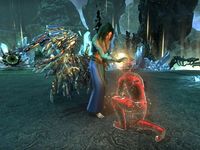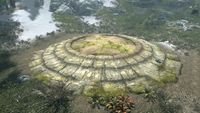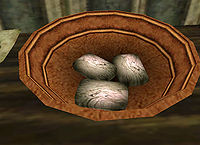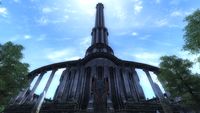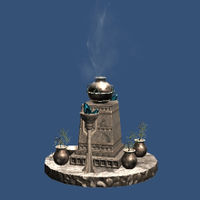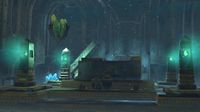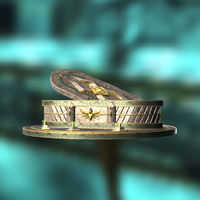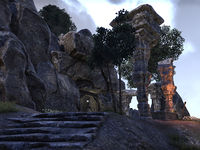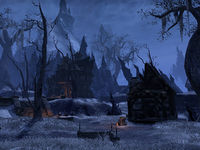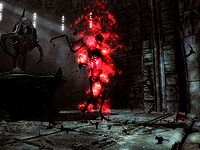Lore:Death/Other
Little is known about afterlife beliefs and funerary customs of most of the nations of Akavir, of the Falmer, of the Maormer, and of many less-cultured beastfolks like the Imga, the Lamia, the Minotaurs, and the Water Dreugh.[1][2][3][4][5][6]
Daedra[edit]
Rynkyus considered the Vestige's banishment of Mehrunes Dagon to the depths of the Deadlands to be as close to death as Daedra can conceive, even though he knew Dagon would return eventually.[7] Daedra cannot die in the mortal sense, but they can sacrifice themselves to Oblivion, described as existence and self-awareness without the ability to see, hear, or affect the world. For an immortal it is unspeakable pain and horror close to hell, a feeling of absolute loss. Eventually all Daedra return from the Wells of Oblivion, but not all return as they were; some Daedra who return from banishment in the wells of Oblivion come back changed, maddened, or sick.[8]
The process of a Dremora being turned into an Incarnate allows their essence to survive, but the mind and purpose are lost, removing any sense of individuality a Daedra has and effectively killing them.[9] For this reason, most Dremora are unwilling to go through the process and those who do are often forced into it.[9][7]
Dragons[edit]
Although dragons are "immortal", they can be killed temporarily. Most dragons were hunted down during the Dragon War or by the Blades after their arrival in Tamriel. These dragons were entombed in burial mounds constructed in the First Era by surviving members of the dragon cult .[10][11] The only way to kill a dragon permanently is to have their soul devoured by another Dragon, or Dragonborn (a mortal with the soul of a Dragon). Devouring a Dragons soul increases the power of the devourer.
Giants[edit]
Giants demonstrate intricate beliefs regarding death. They have places set aside as sacred burial grounds.[12] When a giant is sick or dying, they go to one of these places to die. If a giant dies elsewhere, other giants make sure the body gets to the burial ground. They typically don't live near these sacred locations, and they don't guard them. They simply make use of them.[13]
Goblins and Ogres[edit]
Malacath is worshipped by Ogres and Goblins under the name Muluk, or "the Blue God". However, it is unknown if they follow the Code of Malacath and have similar funerary customs and afterlife beliefs (passing on to the Ashen Forge) to the Orcs or not.[14][15]
Goblins are known to use the heads of dead Goblins, sometimes those of mummifed juvenile Goblins,[16] for their tribal totem staves.
Sload[edit]
Sload are apparently not religious and generally reject worship, but will willingly serve Daedra if they benefit from it.[17] Sload parents care little for the fate of the young, and will often kill them to make Sload Soap, which they use in necromantic rituals.[18] It is unknown whether or not the death of an adult Sload is treated differently.
Tsaesci[edit]
Tsaesci bury their dead with burial masks with serpent and dragon motifs.[19][1] Ancestor worship seems to be an integral part of Tsaesci culture,[20] Water occupies a special place in the Tsaesci faith, as they believe that all waterways connect the realms of the dead and the living.[21]
The Proving Festival is an important, yearly holiday of the Tsaesci to appease the ancestors and prove one's worth.[20] It consists of three proofs which a participant has to pass: The first is the Proof of Reverence by which the ancestors are invoked and invited to enter the living world as spirits. The inhabitants of Hakoshae, imperial descendants of Tsaesci, let a paper lotus be carried down a river. The lotus symbolically swims into the realm of the dead to attract the attention of the ancestors.[21] The second proof is the Proof of Strength. It serves to show the ancestors ones strength and that one can resist various dangers.[22] The last proof is the Proof of Wisdom. Traditionally it consisted of scholars drafting grand essays, writers composing ornate poems or philosophers performing lengthy debates. However in Hakoshae the inhabitants use riddles for that purpose.[23]
Extinct Races[edit]
Ayleids[edit]
Aedric-worshipping Ayleids had very similar traditions on death and afterlife to that of the Altmer. At least some Ayleid cities believed their souls voyaged to the afterlife of Aetherius.[24] The White-Gold Tower was their "Temple of the Ancestors", built it in emulation of the Adamantine Tower, and with Chim-el-Adabal, which they believed to be the crystallized blood of the Heart of Lorkhan, into the tower's Founding-Stone.[25] It is the site where the Ten Ancestors, statues sacred to the Ayleids, were traditionally held. They were spread to various other settlements during the siege of the White-Gold Tower for safekeeping, but were not reunited again until the late Third Era, long after the fall of the Ayleids.[26][27] Little is known if those Ayleids who worship Daedric Princes shared customs with their brethren.
Gallery[edit]
Dwemer[edit]
Dwemeri culture was agnostic and preferred reason to faith, which may or may not explain the lack of burial chambers in their cities.[28]
Lefthanded Elves[edit]
The Lefthanded Elves believed the abdomen was the "throne of the soul".[29] The text Cries from Empty Mouths, originally written in the Sinestral language, was translated by Varederil, a member of the Psijic Order. The text features an intriguing switch between verse and prose. It is unclear whether this was an artistic flourish or a cultural detail. The poem sheds light on the potential beliefs of the Kanuryai, who hold that nothing awaits past the final afterlife. While many stages of death exist, the final afterlife holds nothing. They believe that knowing this makes their people strong. They tell no comforting stories, encouraging them to stay in the here and now.[30]
Nedes[edit]
The ancient Nedes interred their dead within massive chambers and passages beneath their cities and in sacred burial grounds, both commoners and nobles alike.[31][32] They believed their souls would travel to the Stars beyond the heavens of Aetherius through a "Golden Stair".[33]
Other[edit]
Extinct races of the Black Marsh following the devastation of the Knahaten Flu in the mid-Second Era, like the Kothringi, the beastfolk Lilmothiit, and other little known human tribes left little to no known traces of their beliefs about afterlife or their burial practices.[34] It is, however, known that the Kothringi buried their dead in cairns and often adorned these burial sites with glass beads.[35]
Even less is known of the beastfolk known as Bird Men described by Topal inhabiting the City Isle back in the Merethic Era; and of the Lefthanded Elves from Yokuda, thought annihilated by the ancestors of the Redguards and the later sinking of their continent.[36][37]
Afflictions[edit]
Lycanthropy[edit]
Many lycanthropes are claimed by Hircine and spend eternity experiencing the thrill of the hunt in his Hunting Grounds.[38] However, it is possible for a soul to transfer to another afterlife (such as Sovngarde) if their lycanthropy is cured posthumously.[39] Despite popular belief, not all lycanthropes go to the Hunting Grounds when they die. A priest from the Cult of the Ancestor Moth who lived during the Interregnum described the notion of Hircine "claiming" the souls of all lycanthropes as "poetic and misleading", stating that mortals decide the destinations of their own souls through the choices they make in life.[40] A notable example of this is the werewolves who served King Styriche as soldiers in the Gray Host and ended up in Coldharbour.[41]
Vampirism[edit]
Vampires believe their souls are sent to Coldharbour upon their demise.[42] The Tenarr Zalviit clan believes their souls are out of Khenarthi's reach, and the embrace of Molag Bal is all that awaits them should they die.[43] Molag Bal is said to bring down his wrath on vampire clans who interfere with his desires, and that he could bring a vampire clan to ruin should a vampire's soul be taken out of his domain.[44]
References[edit]
- ^ a b Mysterious Akavir
- ^ Pocket Guide to the Empire, 3rd Edition: Other Lands — Imperial Geographical Society, 3E 432
- ^ Pocket Guide to the Empire, 3rd Edition: The Wilds Remain: Valenwood — Imperial Geographical Society, 3E 432
- ^ Tzik'nith's dialogue
- ^ On Minotaurs — Nonus Caprenius, Temporarily Unaffiliated Scholar of Imperial Antiquities
- ^ Brenus Astis' Journal — Brenus Astis
- ^ a b Rynkyus' dialogue in ESO
- ^ Jaciel Morgen's dialogue in Battlespire:Battlespire
- ^ a b Lyranth's dialogue in ESO
- ^ Delphine's dialogue in Skyrim
- ^ The Dragon War — Torhal Bjorik
- ^ Guard dialogue in Skyrim
- ^ Giants: A Discourse — Kord the Curious
- ^ Malacath's dialogue in Oblivion
- ^ Sacred Rites of the Stonechewers — Nellic Sterone
- ^ The Improved Emperor's Guide to Tamriel: Elsweyr — Flaccus Terentius, 2E 581
- ^ A Loathsome Civilization — Telenger the Artificer
- ^ Further Notes on the Sload — Telenger the Artificer
- ^ Ancient Dragonguard Burial Mask description in ESO
- ^ a b The Proving Festival — Laije-Palak Rulician
- ^ a b Domitia Nasica's dialogue from Elder Scrolls Online: Elsweyr
- ^ Vek-Drassi Secunia's dialogue from Elder Scrolls Online: Elsweyr
- ^ Valoria Marius' dialogue from Elder Scrolls Online: Elsweyr
- ^ Urenenya's Lament — Pelorrah, Assistant Sapiarch of Altmeri Heritage, Cloudrest Annex
- ^ Aurbic Enigma 4: The Elden Tree — Beredalmo the Signifier
- ^ Umbacano's dialogue in Oblivion
- ^ Events of Oblivion
- ^ Pocket Guide to the Empire, 3rd Edition: The Temple: Morrowind — Imperial Geographical Society, 3E 432
- ^ Lefthander's Aegis Belts antiquity codex entry in ESO
- ^ Cries from Empty Mouths — Varederil, Psijic Order
- ^ Skyreach Catacombs' description in ESO
- ^ The Howling Sepulchers's description in ESO
- ^ Defaced Nedic Prayer Book
- ^ Lady Clarisse Laurent Answers Your Questions — Lady Clarisse Laurent and Stibbons
- ^ Harpooner's Wading Kilt's codex entries in ESO
- ^ Father Of The Niben — Florin Jaliil
- ^ The Unveiled Azadiyeh Answers Your Questions — The Unveiled Azadiyeh
- ^ Kodlak Whitemane's dialogue in Skyrim
- ^ Events of Skyrim
- ^ The Abbot Crassius Viria Answers Your Questions — Abbot Crassius Viria
- ^ My Beloved Siblings, the Exarchs — Rada al-Saran
- ^ Gwendis' dialogue in ESO
- ^ Yushiha's dialogue during Blood and Tears in ESO: Elsweyr
- ^ A Daedric Proposal — Galdrus Salobar, Sanguimancer Supreme
